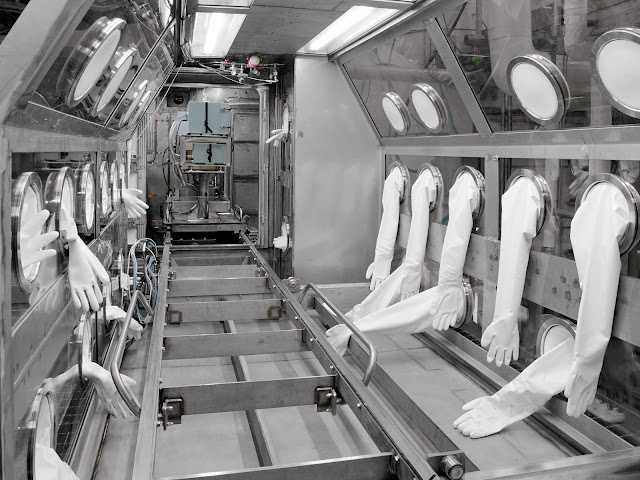 |
Proving Ground. By David Maisel.
|
Photographs by David Maisel
Radius Books/Nora Eccles Harrison Museum of Art, Utah State University, 2020. 250 pp., 145 illustrations, 11¾x11¾x1¼".
David Maisel’s newest book Proving Ground (Radius Books and Nora Eccles Harrison Museum of Art: 2020) is a complex examination of the choices we have made on how to use our Western lands and the implications of those decisions.
The majority of the book features a series of aerial views of Dugway Proving Ground, a site used for the study of chemical and biological weapons, founded in 1942 in the Utah desert. Each of the aerial photographs appears first as a grid of nine square units – a landscape sectioned into equal parts. On the pages that follow, each of the nine pieces gets its own page, bleeding to the edges and filling all the space there is to fill. The experience is one of immersion and disorientation, a series of otherworldly landscapes. The full-page bleeds, printed heavily with metallic ink, are hard to read; the scale is difficult to discern and patterns of lines or concentric circles appear, but how should one differentiate what is visual static from what is meaningful photographic information? The contrasty scenes, with what seem like craters (or are they bushes) and stream beds (or are they drifting snow), and shadows (or are they trenches), and engraved patterns (or are they roads) raise questions in the viewer’s mind, the visual experience producing no clarity.
 |
| Proving Ground. By David Maisel. |
 |
| Proving Ground. By David Maisel. |
The progression of formal and abstract aerial 9-part grids, each followed by their 9 full-page bleeds, is interrupted by color frames taken from drone footage of a chlorine gas release, the putrid neon green screaming the word toxic to us from the page. The images punctuate the book, organized in what appears to be reverse order: the picture of the gas cloud’s greatest spread appears first, subsequent images show the green fog decreasing, until the final picture, which shows a metal container surrounded by orange flames – the detonation that caused the earlier views.
 |
| Proving Ground. By David Maisel. |
The book offers other visual interjections into the collection of metallic aerial views, supplements that expand our visual understanding of Dugway, providing hints into this shrouded and secretive site. Details of the WSLAT (Whole_System_Live_Agent_Test) chamber, in color photographs, look like a set from a science fiction movie, and yet believably are found here on Earth. However, I like to imagine that places like this have a more benevolent function than a biological and chemical weapons test site, functions like space exploration, medical research, or pollution remediation.
 |
| Proving Ground. By David Maisel. |
The supporting texts are placed throughout the book, all printed on translucent paper. In one essay, William L. Fox offers a detailed history of Dugway and nearby Wendover. His essay is an engaging reflection on absence and occupation; real life grids and those of photographic taxonomy; of installations, both military in nature and by contemporary artists; and of secrets, the knowable, and the unknown. Fox writes, “Landscape is what humans make of land; these deserts are not wastelands, but are socially construed to be waste-scapes.”
 |
| Proving Ground. By David Maisel. |
In reflecting on his experience – what led to his interest in Dugway, in visiting at ground level, photographing from above, and the following extensive research through Google Earth and aeronautical charts – David Maisel writes, “Seeing these sites from above at last, I am immediately struck by the various ways that the testing patterns are inscribed into the desert floor. Some seem woven delicately into the landscape, others seem rigorously applied to it.”
§
Ultimately, this book is not about terrain, or the systems and infrastructure applied over it, but the people who are subject to these systems. The book’s first essay, “Nowhere To Be Seen,” by Geoff Manaugh, begins thus, “War is a shaper of landscapes. Its effects span all spatial scales, at every state of the weapons-production process, from industrial extraction and chemical manufacturing to the damage done by machine guns and aerial explosives. War leaves residues. It creates traces.”
But war’s impact is not just on landscapes, of course. Maisel’s art matters because Dugway’s systems are ultimately about people. Photographs of the Utah desert trigger a series of questions that lead us to ask, “How does this relate to the suffering of individuals? How are these traces written on humanity as well as upon the land?”
Purchase Book
Read More Book Reviews
 |
| Proving Ground. By David Maisel. |
 |
| Proving Ground. By David Maisel. |









